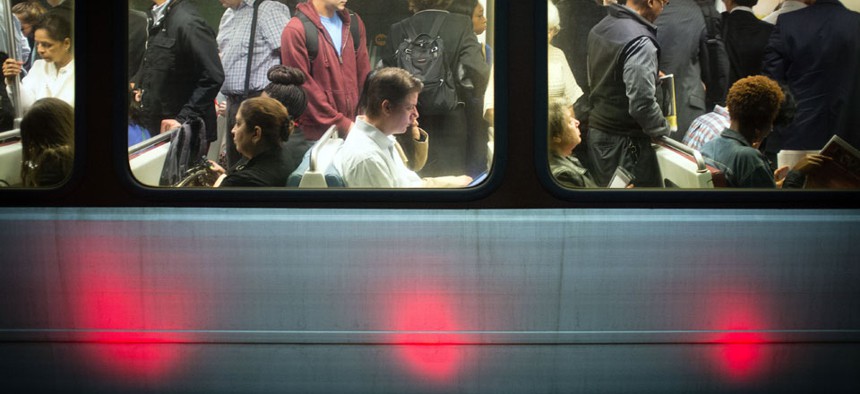DC Metro Buys $184 Million Smart Payment System; Similar System Draws Fire in Canada

Passengers fill up Washington Metro subway cars in Arlington, Va. J. David Ake/AP
Officials bash Ontario's Accenture-built payment system as outmoded and overpriced.
This story has been updated with comment from Accenture.
The Washington Metro transit system has awarded a $184 million contract for a new electronic payment system to a company that built Toronto a similar system, which Canadian officials have bashed for outdated technology and cost overruns.
The Washington Metropolitan Area Transit Authority on Wednesday tapped Accenture to develop a new system capable of accepting automatic payment from current SmarTrip cards, federal government ID cards and mobile phones.
In May 2012, Metro selected Cubic Transportation Systems of San Diego, NTT Data of Japan and Xerox, along with Accenture, as prequalified bidders for the electronic payment system. None of the losing bidders have responded to queries on whether or not they plan to protest.
Metro said the new system “will be among the first transit systems in the United States to use this advanced technology to enhance reliability and make travel more convenient for riders.” The system is based on the Accenture Fare Management Solution, the core of the Presto electronic payment system used by transit agencies in the greater Toronto area.
Metrolinx, which manages the Toronto area transit systems, awarded Accenture a 10-year CA$250 million contract to develop Presto in 2006 for the commuter rail GO Transit system and eight municipal bus systems initially.
In December 2012, Jim McCarter, the Ontario auditor general, said in his annual report that Metrolinx planned to roll out a Presto Next Generation system to, among other things, allow the use of smart phones for payment, as planned by the Washington Metro. Trolleys and buses operated by the Toronto Transit Commission will also use Presto, McCarter said.
McCarter reported, “The total cost of developing the original Presto system and PNG may well be more than $700 million, placing it among the more expensive fare-card systems in the world.” He questioned why Metrolinx did not put expansion of the Presto system out for competitive bids to save money.
Frank Klees, a member of the Ontario Parliament, sharply questioned Metrolinx officials for their continued backing of Presto at a hearing last November. “You are forcing municipalities . . . to take a technology that is light years behind what is available in the marketplace today and you are continuing to pour multi-millions of dollars into the development of the Presto technology just to catch up,” he said.
Klees added that the Waterloo area of Ontario had decided not to sign on to Presto “because they want the advance technology, an open payment system that Metrolinx simply can’t deliver.”
Metrolinx board chairman Robert Prichard rebutted Klees at the hearing. “Presto has 900,000 users,” he said. “Presto is in effect in all our systems, is working and has done over a half a billion dollars of service, so some notion that this isn’t working is something that’s inconsistent with the facts.”
Kate Shenk, an Accenture spokeswoman said Presto will eventually serve triple the number of riders than when the contract awarded. “We have added more features and benefits for riders, including a commuter loyalty program and the latest payment technology," she said. "We are committed to continually making improvements to better serve the transportation needs of the public."
She said Presto is designed to incorporate new technologies. It uses software that can accomodate additional features, such as contactless credit card and mobile wallet payments.
Presto and the Metro system are based on Accenture Fare Management Solution, an open payment system, which helps reduce the total cost of ownership for transit agencies. It is configured to meet the specific needs of each client, thanks to the open architecture, Shenk said.
The Washington area’s new electronic payment system will eventually support the 106 mile Metrorail system, which makes 218 million trips a year; the Metrobus system, which makes 132 million trips a year; and Metro garages.
Metro said that later this year Accenture will conduct a pilot to test the new system in 10 Metrorail stations, aboard 50 branded-route Metrobuses, and in two parking lots. Additionally, 2,000 Metro riders will be selected to participate in the pilot program to test the performance and reliability of the new system.
Metro added that it will install new faregates and vending machines to support the new system, with travel transactions and fare calculations performed by a central data system, which will be easier to maintain and manage than the current system.
After the new payment system is fully installed, Metro said it will no longer use paper fare cards, which it has been using since the system opened in 1976.
Get the Nextgov iPhone app to keep up with government technology news.
NEXT STORY: Marines Again Eye Virtual Desktop Infrastructure






